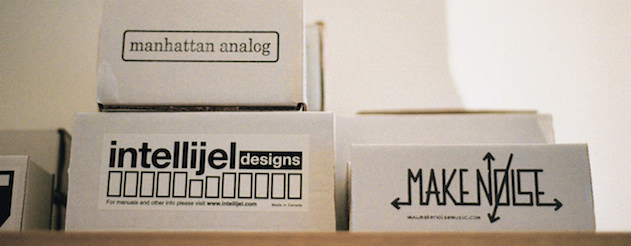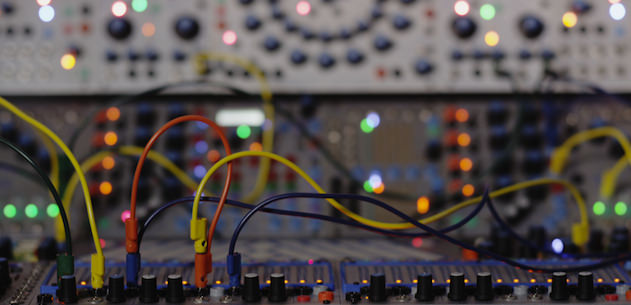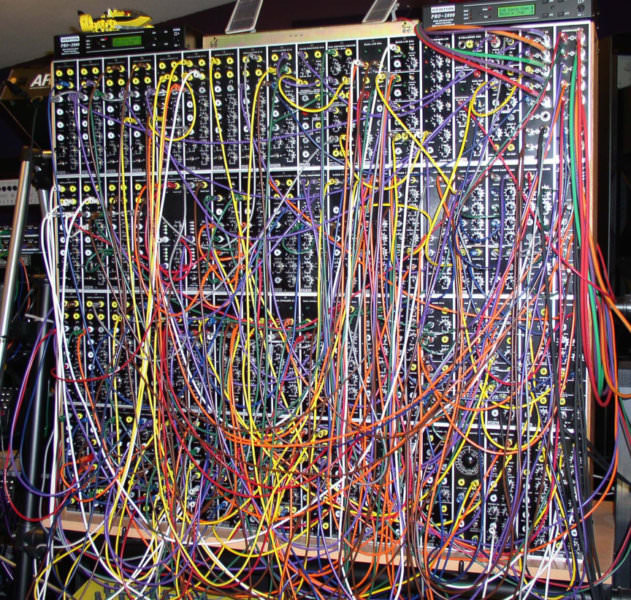
Back From The Dead
Modular synths predate their compact, fixed-architecture cousins by over a decade, having first been commercially manufactured by Bob Moog and Don Buchla in 1963, seven years before the release of the Minimoog. Even Roland, who entered the synth market a few years after the introduction of the Minimoog, produced the wonderful System 700 and System 100m modulars before switching their attention solely to fixed-architecture synths.
Moog and Roland’s withdrawal from modular synth production – in 1981 and 1984 respectively – was emblematic of a larger shift in electronic music trends which could be traced back to the introduction of the Minimoog in 1970: musicians were increasingly turning to smaller, more compact and cheaper fixed-architecture synths. By the 90s, modular synths were widely considered an archaic relic of a bygone era, esoteric and interesting but barely relevant to modern musicians.
Amm explains that the modular synth resurgence began as a vintage revival targeted at a very small niche market: “Vintage modular systems started becoming more scarce and sought-after, so companies like Modcan and Doepfer introduced new modular systems in the 90s to meet the demand. To start they were mainly catering to older people who had probably lusted after Moog modulars in the 70s, so what they were offering were basically recreations of classic subtractive analogue synthesis modular systems.”
Modcan’s Bruce Duncan began building modular synth equipment as a hobby in 1994 when he experienced a slow-down in his day job building prototype models for industrial designers. “I had always been fascinated with synthesisers and had owned many of the early polyphonic models from the late 70s onward,” he explains. “My first modular was a Serge, circa 1980, which I bought locally second-hand. It had been assembled from a kit. What got me started building was a need to expand the Serge. The filters and envelopes were lacking in my system and the cost for new Serge panels was beyond my financial capabilities at the time. I built a few prototypes and enjoyed the process so much I decided that it could become a fun secondary job for me when regular day job was slow.
“I met a guy who was a fellow synth nerd at a party and he knew a bit about HTML and helped me put together a very basic website which became modcan.com. I posted some of the early modules and started promoting my work on the Analogue Haven forum. Before long people were buying modules to augment their Serges and as free-standing systems once I had enough modules to cover all the basics. I had a friend that had some under-employed buddies and they built the modules for me in their bedrooms. I would drive over to their place and drop off the parts, boards and panels every time I received an order.
“It was very low production from about 1996 to 2004. Maybe 100 modules a year, maximum. I was still working in the model business and was happy to keep it all small scale as it really was more of a hobby at that time. In 2004 I received a large commission for a very big system and I was fed up with my job so I decided it was time to see if I could make synth building a full-time occupation. I rented a warehouse space near my home in the east end of Toronto and away I went. Since that time it’s been a six-day-a-week job with barely a break.”
Modulars go indie
While larger companies like Modcan and Doepfer led the way in revitalising the modular synth market during the late 1990s, they’ve since been joined by a vast cottage industry of independent manufacturers. Amm takes up the story: “The real resurgence started about six or seven years ago and has really ramped up in the last couple of years – that’s basically when a lot of new, one-person start-up companies began popping up with their own modules, mainly in Doepfer-style Eurorack format. This Eurorack format is smaller and typically cheaper than modular systems of the past, so it really caught on.
“I think this is when it started to get really interesting, because it’s no longer all about vintage recreations – there’s that, but everything else has been thrown in too – digital, analogue, valves, sampling, complex sequencing, interfacing between the modular and the computer DAW environment, just about anything you can think of. The increase in modular activity is really a result of the reciprocal relationship between the modular synthesiser manufacturers and their users; the users crave more and more innovative sounds and approaches to synthesis, and there seems to be no shortage of new manufacturers who thrive on the challenge to contribute something unique to the pot. So I think a huge factor for the modular resurgence is fuelled by the fact that the internet allows this exchange of ideas and information.
“I think another significant reason has to do with the fact that electronic music is so common now, and people are burned out on hearing run-of-the-mill synth sounds, because they’re everywhere. The modular offers a sonic alternative to run-of-the-mill!”


03.44 AM
Hell yes! Great article. Can’t wait for the doc.
08.40 PM
I am in the process of falling into the abyss. I fear it will be a magnificent obsession for me.
06.47 AM
Funny watched this movie on Netflix over a buddies house and seen myself in it, even one of the guys had same look as me. I can relate with fighting with the outside world to return to my modular cave. Haha
In fact it was all rocket science to my buddy, although to me everything these geeks and modular synth scientist said made sense.